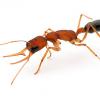Has anyone tried keeping army ants before? I guess you'd need a huuuuge terrarium to house them in.
- Formiculture.com
- Forums
- Gallery
- Members
- Member Map
- Chat

Has anyone tried keeping army ants before? I guess you'd need a huuuuge terrarium to house them in.
Yes. Look at Purdue Entomology's old journal. They may have been successful, but the queen died for unknown reasons.
Yes. Look at Purdue Entomology's old journal. They may have been successful, but the queen died for unknown reasons.
Maybe she was infertile. That may be an odd claim but hear me out. Neivamyrmex found colonies through a method known as colony fragmentation, in which virgin gynes and a group of a few thousand or so workers head out to start new colonies, bringing with them a good-sized batch of brood items. Once the ants are settled, the queen produces sex pheromones, which draw in males. The males mate with the queen, thereby inseminating her before retiring (aka being eaten by the workers). The queen then assumes a physogastric state, producing eggs by the thousands, until she starts thinning out once the eggs hatch and they go on the move once again. However, I haven't looked at the journal in a while, so if the queen did lay eggs and they produced workers instead of males, then I've got nothing.
Has anyone tried keeping army ants before? I guess you'd need a huuuuge terrarium to house them in.
I'd assume you're talking about keeping some of the larger Doryline species such as Eciton and Dorylus. Aside from a few small laboratory colonies, I would say that no one has really tried keeping the larger Doryline species. On the flip-side, I would say that in order to keep a colony, you would need something like one of those huge zoo vivariums. Ugh, why hasn't any zoo tried that!? Eciton burchellii would look amazing on display! Maybe have a colony of Atta cephalotes in with them, as Eciton never attack Atta, just kinda passing through trails of them or finding a bride or something when they encounter a foraging trail. Unsurprisingly, Nomamyrmex esenbeckiii think they're wusses. ![]()
Currently Keeping:
Camponotus chromaiodes, Camponotus nearcticus, Stigmatomma pallipes, Strumigenys brevisetosa, Strumigenys clypeata, Strumigenys louisianae, Strumigenys membranifera, Strumigenys reflexa, Strumigenys rostrata
my personal theory as to why the eggs in Purdue's colony didn't develop is that they were waiting until after hibernation. I believe that like most other ants, the queen produced a batch of brood that would wait until spring to hatch. This also explains why the colony was acting less nomadic than other people's neivamyrmex colonies, as they were settling down for winter.Maybe she was infertile. That may be an odd claim but hear me out. Neivamyrmex found colonies through a method known as colony fragmentation, in which virgin gynes and a group of a few thousand or so workers head out to start new colonies, bringing with them a good-sized batch of brood items. Once the ants are settled, the queen produces sex pheromones, which draw in males. The males mate with the queen, thereby inseminating her before retiring (aka being eaten by the workers). The queen then assumes a physogastric state, producing eggs by the thousands, until she starts thinning out once the eggs hatch and they go on the move once again. However, I haven't looked at the journal in a while, so if the queen did lay eggs and they produced workers instead of males, then I've got nothing.Yes. Look at Purdue Entomology's old journal. They may have been successful, but the queen died for unknown reasons.
I'd assume you're talking about keeping some of the larger Doryline species such as Eciton and Dorylus. Aside from a few small laboratory colonies, I would say that no one has really tried keeping the larger Doryline species. On the flip-side, I would say that in order to keep a colony, you would need something like one of those huge zoo vivariums. Ugh, why hasn't any zoo tried that!? Eciton burchellii would look amazing on display! Maybe have a colony of Atta cephalotes in with them, as Eciton never attack Atta, just kinda passing through trails of them or finding a bride or something when they encounter a foraging trail. Unsurprisingly, Nomamyrmex esenbeckiii think they're wusses.Has anyone tried keeping army ants before? I guess you'd need a huuuuge terrarium to house them in.
Edited by Manitobant, January 14 2020 - 9:57 AM.
0 members, 0 guests, 0 anonymous users